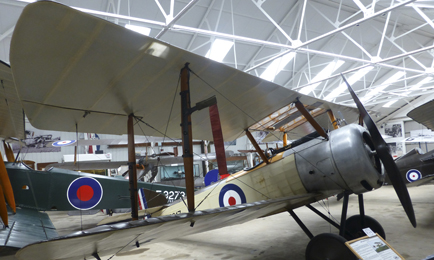Flying Lizzie: The Lysander was designed for low-level reconnaissance
Motor-racing champion Richard Shuttleworth was badly hurt in one race so he took up flying because he thought it was safer. He started a collection of cars and aircraft at the family estate in Old Warden, Bedfordshire.
While flying at night on 2 August 1940, Shuttleworth fatally crashed, and four years later his devastated mother formed a trust in his name “for the teaching of the science and practice of aviation and of afforestation and agriculture”.
Today the Shuttleworth Collection depicts the history of flight from the early 1900s to the 1950s, showing how aircraft operated in the pioneering years, were rapidly developed through necessity during the First World War, were used for leisure and business in the 1920s and 1930s, and once again became fighting machines in the Second World War.
One of the stars of the collection is the world’s oldest airworthy plane, the Blériot XI, designed by Louis Blériot. It has a wooden fuselage frame braced with supporting struts and tension wires and is only partially fabric covered. The wings, also of wood and fabric covered, include wires to enable them to be warped for lateral control. In 1909 Blériot won a competition for the first cross-Channel flight, winning a £1,000 prize. The aircraft was exhibited to large crowds at the newly opened Selfridges store in London the following week.
Shuttleworth also houses the oldest airworthy British aircraft, a Blackburn monoplane Type D. Manufacturer Robert Blackburn was one of Britain’s earliest aviation pioneers, establishing workshops in Leeds in 1908. In 1912 he received an order from Cyril Foggin, a newly qualified pilot, to build a single-seat monoplane based on the firm’s Mercury design, but more compact and streamlined. The Type D had aluminium sheeting around the cockpit, and featured a radial cowl above the rotary engine to reduce the tendency for hot oil and exhaust gas to blow into the pilot’s face.
Another noteworthy aircraft on display is the Sopwith Pup, which was hurriedly designed with the aim of ending German air supremacy in the First World War. The Pup’s design was one of simplicity, using a fabric-covered wooden structure to achieve low weight. It was considered to be under-powered, but was highly manoeuvrable, and commanded respect from enemies.
Unmissable is the red DH88 Comet. De Havilland entered the aircraft into the 1934 MacRobertson air race from England to Australia, which was held to mark the centenary of the foundation of the state of Victoria. The DH88 was designed to meet the conditions of the race, and featured advanced wooden stressed-skin construction, a retractable undercarriage and two pitch propellers.
The aircraft was designed, built and flown in nine months. It won an award for its speed.
One of the most striking aircraft in the collection is the Westland Lysander, affectionately referred to as the Lizzie, which was built for low-level reconnaissance. It has a distinctive high wing which incorporates leading-edge slats and trailing-edge flaps to give short-take-off-and-landing capability.
The Lysander entered RAF service during 1938 and was later to become the first British aircraft based in France to see wartime action. It was withdrawn from the country following the evacuation at Dunkirk in 1940.
It subsequently played a vital role as a ‘spy taxi’ – dropping secret agents and equipment behind enemy lines.

Great War veteran: The Sopwith Pup first saw action in 1916
Additional photographs can be viewed here.
Five things to see
1. Vintage aircraft: The collection also includes a Bristol Boxkite, English Electric Wren, Hawker Sea Hurricane, and Supermarine Spitfire.
2. Engines: Get up close to more than 30 engines from the likes of Armstrong-Siddeley, Bristol and Rolls-Royce.
3. Vehicles: View a display of vintage and veteran cars, bikes and agricultural machines.
4. Personal effects: Shuttleworth houses many items, from uniforms to tools, that once belonged to pilots and maintenance crews.
5. Archives: The walls of each hangar are covered in photos, posters and diagrams.
The Shuttleworth Collection is open daily, and flying displays take place from May to October. See: www.shuttleworth.org